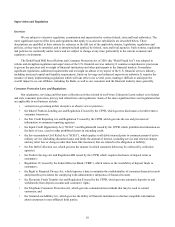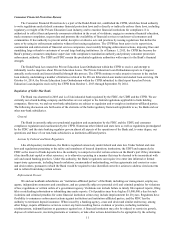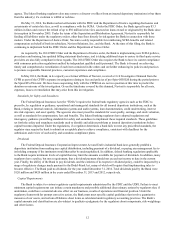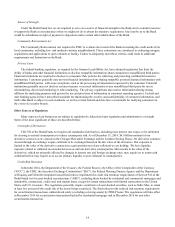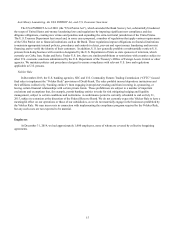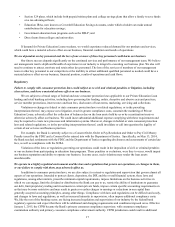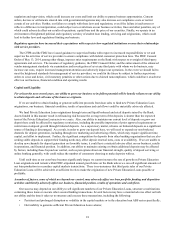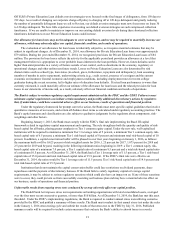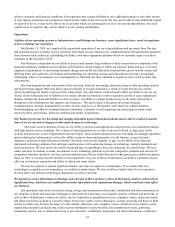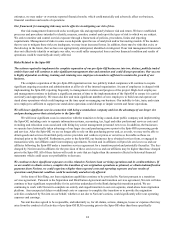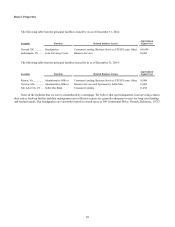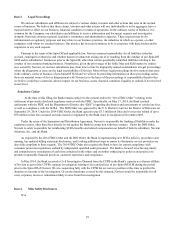Sallie Mae 2014 Annual Report Download - page 22
Download and view the complete annual report
Please find page 22 of the 2014 Sallie Mae annual report below. You can navigate through the pages in the report by either clicking on the pages listed below, or by using the keyword search tool below to find specific information within the annual report.Adverse market conditions or an inability to effectively manage our liquidity risk could negatively impact our ability to meet
our liquidity and funding needs, which could materially and adversely impact our business operations and our overall
financial condition.
We must effectively manage the liquidity risk to which we are exposed. We require liquidity to meet cash requirements
such as day-to-day operating expenses, extensions of credit on our Private Education Loans, meet demand for deposit
withdrawals and payment of required dividends on our preferred stock. Our primary sources of liquidity and funding are from
customer deposits, payments made on Private Education Loans and FFELP Loans that we hold, and proceeds from loan sales
and securitization transactions we undertake. We may maintain too much liquidity, which can be costly, or we may be too
illiquid, which could result in financial distress during times of financial stress or capital market disruptions.
Unexpected and sharp changes in the overall economic environment may negatively impact the performance of our loan
and credit portfolios and cause increases in our provision for loan losses and charge-offs.
Unexpected changes in the overall economic environment, including unemployment, may result in the credit performance
of our loan portfolio being materially different from what we expect. Our earnings are dependent on the expected future
creditworthiness of our education loan customers, especially with respect to our Private Education Loan portfolio. We maintain
an allowance for Private Education Loan losses based on expected future charge-offs expected over primarily the next year,
which considers many factors, including levels of past due loans and forbearances and expected economic conditions. However,
management’s determination of the appropriate allowance level may under- or over-estimate future losses. If the credit quality
of our customer base materially decreases, if a market risk changes significantly, or if our reserves for credit losses are not
adequate, our business, financial position, results of operations and cash flows could be adversely affected.
Our use of derivatives to manage interest rate sensitivity exposes us to credit and market risk that could have a material
adverse effect on our earnings.
We maintain an overall interest rate strategy that uses derivatives to minimize the economic effect of interest rate
changes. Developing an effective hedging strategy for dealing with movements in interest rates is complex, and no strategy can
completely avoid the risks associated with these fluctuations. For example, our education loan portfolio remains subject to
prepayment risk that could cause it to be under- or over-hedged, which could result in material losses. In addition, our interest
rate risk management activities expose us to mark-to-market losses if interest rates move in a materially different way than was
expected when we entered into the related derivative contracts. As a result, there can be no assurance hedging activities using
derivatives will effectively manage our interest rate sensitivity, have the desired beneficial impact on our results of operations
or financial condition or not adversely impact our liquidity and earnings.
Our use of derivatives also exposes us to market risk and credit risk. Market risk is the chance of financial loss resulting
from changes in interest rates and market liquidity. Some of the swaps we use to economically hedge interest rate risk between
our assets and liabilities do not qualify for hedge accounting treatment. Therefore, the change in fair value, called the “mark-to-
market,” of these derivative instruments is included in our statement of income. A decline in the fair value of these derivatives
could have a material adverse effect on our reported earnings.
We are also subject to the creditworthiness of other third parties, including counterparties to derivative transactions. For
example, we have exposure to the financial conditions of various lending, investment and derivative counterparties. If a
counterparty fails to perform its obligations, we could, depending on the type of counterparty arrangement, experience a loss of
liquidity or an economic loss. In addition, we might not be able to cost effectively replace the derivative position depending on
the type of derivative and the current economic environment, and thus be exposed to a greater level of interest rate which could
lead to additional losses. Our counterparty exposure is more fully discussed in Part II, Item 7. “Management’ s Discussion and
Analysis of Financial Condition and Results of Operations - Liquidity and Capital Resources - Counterparty Exposure.” If our
counterparties are unable to perform their obligations, our business, financial condition and results of operations could suffer.
Defaults on education loans, particularly Private Education Loans, could adversely affect our business, financial position,
results of operations and cash flows.
We bear the full credit exposure on Private Education Loans. Delinquencies are an important indicator of the potential
future credit performance for Private Education Loans. Our delinquencies, as a percentage of Private Education Loans in
repayment, were 2.0 percent at December 31, 2014.
In connection with the Spin-Off, we conformed our policy with that of the Bank to charge off loans after 120 days of
delinquency. We also changed our loss confirmation period — the expected time between a loss event and management's
estimates of the uncollectability of debt — from two years to one year to reflect both the shorter charge-off policy and its
related servicing practices. Prior to the Spin-Off, the Bank sold all loans past 90 days delinquent to an entity that is now a
subsidiary of Navient. Post-Spin-Off, sales of delinquent loans to Navient will be significantly curtailed. Similarly, pre-Spin-
20


